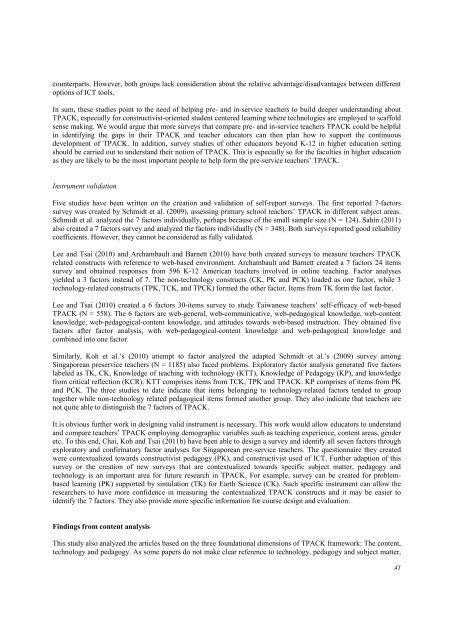Download Complete Issue in PDF - Educational Technology & Society
Download Complete Issue in PDF - Educational Technology & Society
Download Complete Issue in PDF - Educational Technology & Society
You also want an ePaper? Increase the reach of your titles
YUMPU automatically turns print PDFs into web optimized ePapers that Google loves.
counterparts. However, both groups lack consideration about the relative advantage/disadvantages between different<br />
options of ICT tools.<br />
In sum, these studies po<strong>in</strong>t to the need of help<strong>in</strong>g pre- and <strong>in</strong>-service teachers to build deeper understand<strong>in</strong>g about<br />
TPACK, especially for constructivist-oriented student centered learn<strong>in</strong>g where technologies are employed to scaffold<br />
sense mak<strong>in</strong>g. We would argue that more surveys that compare pre- and <strong>in</strong>-service teachers TPACK could be helpful<br />
<strong>in</strong> identify<strong>in</strong>g the gaps <strong>in</strong> their TPACK and teacher educators can then plan how to support the cont<strong>in</strong>uous<br />
development of TPACK. In addition, survey studies of other educators beyond K-12 <strong>in</strong> higher education sett<strong>in</strong>g<br />
should be carried out to understand their notion of TPACK. This is especially so for the faculties <strong>in</strong> higher education<br />
as they are likely to be the most important people to help form the pre-service teachers’ TPACK.<br />
Instrument validation<br />
Five studies have been written on the creation and validation of self-report surveys. The first reported 7-factors<br />
survey was created by Schmidt et al. (2009), assess<strong>in</strong>g primary school teachers’ TPACK <strong>in</strong> different subject areas.<br />
Schmidt et al. analyzed the 7 factors <strong>in</strong>dividually, perhaps because of the small sample size (N = 124). Sah<strong>in</strong> (2011)<br />
also created a 7 factors survey and analyzed the factors <strong>in</strong>dividually (N = 348). Both surveys reported good reliability<br />
coefficients. However, they cannot be considered as fully validated.<br />
Lee and Tsai (2010) and Archambault and Barnett (2010) have both created surveys to measure teachers TPACK<br />
related constructs with reference to web-based environment. Archambault and Barnett created a 7 factors 24 items<br />
survey and obta<strong>in</strong>ed responses from 596 K-12 American teachers <strong>in</strong>volved <strong>in</strong> onl<strong>in</strong>e teach<strong>in</strong>g. Factor analyses<br />
yielded a 3 factors <strong>in</strong>stead of 7. The non-technology constructs (CK, PK and PCK) loaded as one factor, while 3<br />
technology-related constructs (TPK, TCK, and TPCK) formed the other factor. Items from TK form the last factor.<br />
Lee and Tsai (2010) created a 6 factors 30-items survey to study Taiwanese teachers’ self-efficacy of web-based<br />
TPACK (N = 558). The 6 factors are web-general, web-communicative, web-pedagogical knowledge, web-content<br />
knowledge, web-pedagogical-content knowledge, and attitudes towards web-based <strong>in</strong>struction. They obta<strong>in</strong>ed five<br />
factors after factor analysis, with web-pedagogical-content knowledge and web-pedagogical knowledge and<br />
comb<strong>in</strong>ed <strong>in</strong>to one factor.<br />
Similarly, Koh et al.’s (2010) attempt to factor analyzed the adapted Schmidt et al.’s (2009) survey among<br />
S<strong>in</strong>gaporean preservice teachers (N = 1185) also faced problems. Exploratory factor analysis generated five factors<br />
labeled as TK, CK, Knowledge of teach<strong>in</strong>g with technology (KTT), Knowledge of Pedagogy (KP), and knowledge<br />
from critical reflection (KCR). KTT comprises items from TCK, TPK and TPACK. KP comprises of items from PK<br />
and PCK. The three studies to date <strong>in</strong>dicate that items belong<strong>in</strong>g to technology-related factors tended to group<br />
together while non-technology related pedagogical items formed another group. They also <strong>in</strong>dicate that teachers are<br />
not quite able to dist<strong>in</strong>guish the 7 factors of TPACK.<br />
It is obvious further work <strong>in</strong> design<strong>in</strong>g valid <strong>in</strong>strument is necessary. This work would allow educators to understand<br />
and compare teachers’ TPACK employ<strong>in</strong>g demographic variables such as teach<strong>in</strong>g experience, content areas, gender<br />
etc. To this end, Chai, Koh and Tsai (2011b) have been able to design a survey and identify all seven factors through<br />
exploratory and confirmatory factor analyses for S<strong>in</strong>gaporean pre-service teachers. The questionnaire they created<br />
were contextualized towards constructivist pedagogy (PK), and constructivist used of ICT. Further adaption of this<br />
survey or the creation of new surveys that are contextualized towards specific subject matter, pedagogy and<br />
technology is an important area for future research <strong>in</strong> TPACK. For example, survey can be created for problembased<br />
learn<strong>in</strong>g (PK) supported by simulation (TK) for Earth Science (CK). Such specific <strong>in</strong>strument can allow the<br />
researchers to have more confidence <strong>in</strong> measur<strong>in</strong>g the contextualized TPACK constructs and it may be easier to<br />
identify the 7 factors. They also provide more specific <strong>in</strong>formation for course design and evaluation.<br />
F<strong>in</strong>d<strong>in</strong>gs from content analysis<br />
This study also analyzed the articles based on the three foundational dimensions of TPACK framework: The content,<br />
technology and pedagogy. As some papers do not make clear reference to technology, pedagogy and subject matter,<br />
41

















